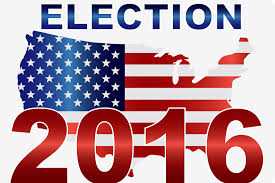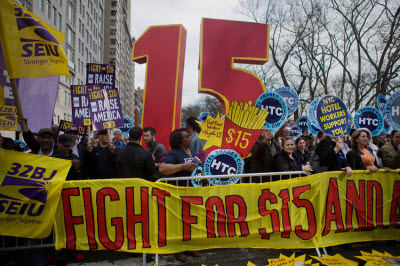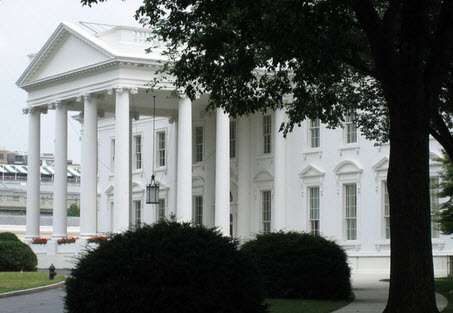Did They Take Away Your Vote
in Our (Sort of) Democracy?
With Donald Trump running away with the Republican party and its establishment in a tizzy over how to upend him, the usual quadrennial
Start with the primaries. The states and the political parties are free to mostly do as they please, so instead of a single primary day in all the states, the dates are scattered across the calendar, making the candidates zig-zag frenziedly around the country. Two states — Iowa and New Hampshire — jump ahead of all the rest to win the outsized attention of candidates for months, even though they have only a combined 1.4% of the population. And some states use caucuses, unaccountably lauded as a wonderful example of democracy in action considering that folks are denied a secret ballot, must therefore visibly reveal their preference, and are subjected to peer pressure to change it.
We all then became aware of something called “superdelegates”, the power élite’s thumb on the scale as a counterweight should your vote meet with their displeasure. Superdelegates, which inhabit only the Democratic party, are party factotums who are simply handed the right to be a delegate by virtue of being a somebody — a former or current elected official of a state such as governor, senator, House representative, or just a party faithful or worker such as a member of the Democratic National Committee.
Across the states there are 712 superdelegates — a big number — out of a total of 4,763 who will vote at the Democratic convention. That’s just shy of 30% of the 2,383 a candidate needs to win, a significant dilution of the votes of the rest of us. Election-savvy Hillary Clinton is running well ahead, so she didn’t really need them, but she had lined up most of the superdelegates well in advance, probably before Bernie Sanders even knew what they were.
The superdelegate ruse was adopted by Democrats in 1982 when the party’s establishment, stung by the 1972 rout of George McGovern by Richard Nixon, and then by Jimmy Carter’s edging aside Ted Kennedy at the 1980 Democratic convention, decided they should have a way to prevent an insurgent grass roots populist from becoming the party’s candidate. Steamrollered by the Trump juggernaut, it is now the Republican party kicking itself for not having done the same. conventions, on the other hand…
While superdelegates are worth noting as anti-democratic, primaries are nonetheless part of a far more democratic process than what had gone before — the behind-closed-doors anointing of party candidates at the summer conventions, where caricatured cigar-puffing power-brokers once trampled the will of the people in “smoke-filled rooms”. Consider the 1960 Democratic convention in Chicago. In the midst of the Vietnam War, Lyndon Johnson had decided not to run. His vice-president, Hubert Humphrey, ran in his stead. Anti-war candidate Robert Kennedy had been assassinated and party kingmakers were apprehensive that his delegates might commit to the other anti-war candidate, Eugene McCarthy, putting him ahead of Humphrey. Even though 80% of voters had voted for the anti-war candidates in those states which held primaries, the party potentates chose Humphrey, who went on to lose to Richard Nixon.
That power grab and the street violence which the Walker Report would later call a “police riot” for their brutal crackdown on protesters in the streets of Chicago are what led all states to adopt either the primary or caucus system for deciding on party candidates democratically, reducing the conventions to a formality. second thoughts?
The ascendancy of Donald Trump against all attempts to eliminate him has caused the Republican establishment to pine for the good old days. By the beginning of March behind the scenes speculation about how to unseat Trump at the convention had broken cover, irrespective of the betrayal that would mean of primary voters. Nevertheless, the subject is alive, such as Chris Christie saying he has advised Trump not to bolt the party if he is denied the nomination. “I’ve urged him not to do that”, said Christie, suggesting that it had indeed been considered. The prospect of Trump as the nominee even stirred Mitt Romney to re-emerge four years later to deliver a speech outlining the catastrophe Trump portends for the Republican party, calling Trump “a phony, a fraud”. The maneuver backfired badly. At this writing, over 70 Republican experts on foreign policy and national security issued a press release pledging to oppose the front-runner. Anti-Trump groups poured millions of dollars into ad campaigns in Florida and Ohio, both winner-take-all states, in the hopes of preventing Trump from pocketing all 165 delegates in their March 15th primaries. It worked only in Ohio where favorite son Governor John Kasich won by a good margin. And now we are now told that the people do not decide who is to be the nominee, the Republican Party decides, and it sets the rules for the convention that will engineer that decision. That tells us that the months of primaries and caucuses are only meant to give the process a democratic patina. Trump is archly threatening at his increasingly violent rallies that if there is an attempt to take the nomination from him, “there is going to be trouble”. Cleveland must be wishing it hadn’t won the bid to hold the convention. off to college
Bad enough that in some states the primary winner walks away with all the delegates. Worse is that the practice becomes almost universal come November when the constitutional abomination only Supreme Court originalists could love takes over: the Electoral College.
Instead of your vote for the presidency awarded directly, “Each State shall appoint…a Number of Electors” in place of you, and in 48 of the states, all of their votes are given to the winning candidate in those states. Only Maine and Nebraska apportion votes. As with the primaries, if you live in a state where a majority, however slim, vote for the other party, you might as well not exist. Your vote is nullified. Or you could say it has been stolen and given to the opposing candidate without your consent.
Because minority votes are not counted at all when all of a state’s votes are handed to the majority candidate, the effect of the Electoral College is for states with foreordained outcomes to be ignored. In 2012, candidates campaigned in only 10 states after the conventions, Romney bypassing Democratic strongholds on the West Coast and the Northeast, and Obama flying over the South and Plains states. The other 40 states never got to see the candidate who took their votes for granted. Why spend resources on states where the minority votes are tossed in the trash? The result is lower turnout in the states that only get to watch from the sidelines.
Far more serious is that the Electoral College contrivance makes possible going against the public will and taking the presidency from the candidate who has won the national vote. It has happened four times, most notably for current generations in 2000, when George W. Bush was declared the winner despite having lost to Al Gore by more than a half million votes. (The other three instances were in the 19th Century).
The election of 2004 came close. Had 60,000 Ohio votes shifted John Kerry’s way, handing him all of that state’s Electoral College votes, he would have won the presidency despite Bush’s lead of some three million in the popular vote count. Not quite a democracy.
There is widespread dislike of the Electoral College. But as with constitutional originalists such as Antonin Scalia, there are those who cling with idolatrous zeal to every word of this increasingly creaky document from two and a quarter centuries ago. And so, we have absolutists against any change such as Ted Cruz saying, “the founding fathers fought and bled for freedom and then crafted the most miraculous political document ever conceived, our Constitution”. Without the Constitution’s Electoral College provision, “You would not have any real representation of the people who are basically in the middle of the country”, is Utah Senator Orrin Hatch’s concern. “If it was just the large states, we’d be dominated completely.” Each state is accorded electoral college votes equal to its number of House representatives and its two senators, so what Hatch is really saying is that small states should have greater proportionate weight than larger states. That’s so because their two senator votes are the same as the senator votes of the largest states. At the extremes, the two senator votes fatten California’s electoral count by about 4% but they triple Wyoming’s, which has but one representative. Ditto Montana, the Dakotas, Alaska, Vermont, Delaware and the District of Columbia. Next come five states with two House representatives and four college votes. For them, the senator bonus doubles their heft beyond their population’s proportion to the country. You could that these are the states’ superdelegates. our ossified constitution
There will be editorials as the election nears bemoaning these facts and arguing that the Electoral College should be abolished. We hear this every four years, but constitutional amendments have become all but impossible in this polarized country. The steep climb that Article V dictates — endorsement by two-thirds of the House and the Senate and then ratification by three-quarters of the state legislatures — is insurmountable.
It didn’t used to be that way when there was a country unified in fixing what was not working. Testimony is that five amendments were adopted in just the 20 years of 1951 to 1971. That could have been six; a move to abolish the Electoral College in 1970 was filibustered out of consideration by small state senators. workarounds
There is something ludicrous about being so hog-tied by the hoary Constitution that schemes have been hatched to outwit it instead of fixing it. But contrivances have been put forth to do so, given the impossibility of a repeal amendment. States could agree to abolish winner-take-all and split their electoral votes proportionate to the popular vote for each candidate. But the bigger states doing so would, by splitting their votes, empower still further the bloc of small states that would hand all votes to one party.
More vigorous is the proposed National Popular Vote interstate compact. States collectively representing 30% of the Electoral College have so far banded together in an agreement that they will cast all their votes for the candidate who wins the national popular vote, a pledge to become effective once states representing half the college’s votes (270) sign on. Enough further states have pending legislation that would bring the total to 46%.
But all such schemes have problems. Voters would likely challenge their state if it swung all its electoral votes to the national winner when the majority of the state’s voters had voted for the losing candidate. Doesn’t that steal your vote just as does the Electoral College? Actually, it doesn’t, because your vote will have been counted in arriving at the national total. It’s more like a committee changing its vote to unanimous as an expression of unity once the actual vote’s outcome is clear.
The National Popular Vote also overwhelms the holdout states who do not join in the compact, especially the small states with their supersenators. Outsider states would probably build a case against the NPV that it’s somehow unconstitutional for a state to throw all its votes to the candidate that a majority of its citizens voted against.
These defects in our voting practices — they’re just the half of it. We haven’t even touched on gerrymandering and the raft of new state laws that are engineered to throw the vote to one party, subjects we’ll get to next. Taken all together, it’s a stretch that we call this a democracy, and a wonder why we haven’t insisted that it be fixed.
irritations over how we vote for president have been muted. But as the election itself approaches, we’ll soon be in dudgeon that another four years have passed and we’re still stuck with the same clunky system.






